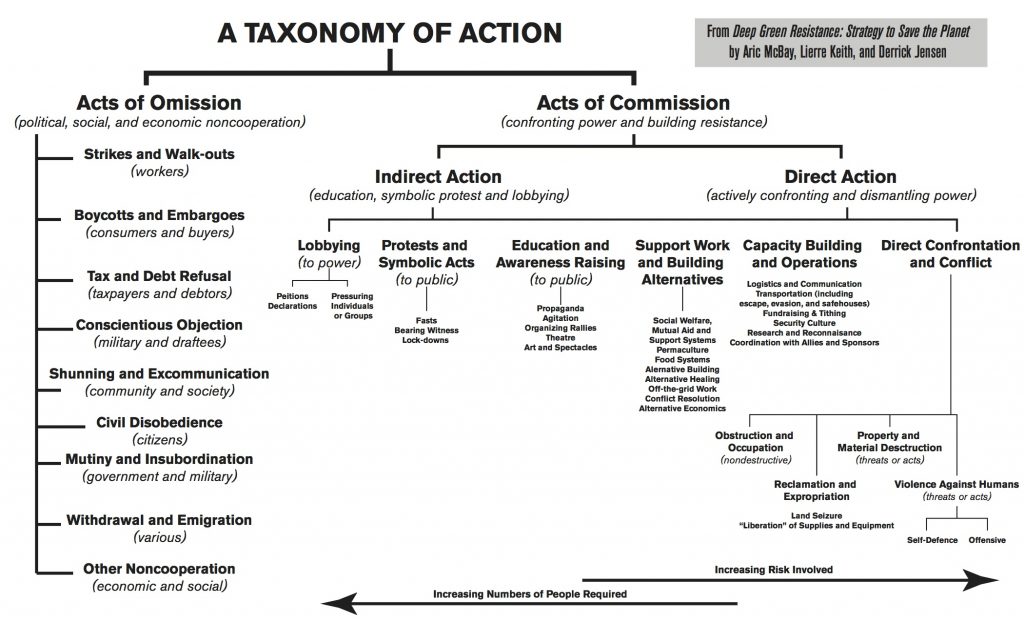Editor’s note: Too often, activists fail to understand tactics and strategy, especially when we are matched against business people, law enforcement, and even military professionals. This makes us easy to out-think, outmaneuver, and defeat. It is essential that we remedy this discrepancy. This article is excerpted from Chapter 12, Introduction to Strategy, in the book Deep Green Resistance: Strategy to Save the Planet, by Lierre Keith, Derrick Jensen, and Aric McBay. The book aims to introduce readers to basic and intermediate strategic principles and is an essential manual for activists in the age of eco-collapse.
Strategy and tactics form a continuum; there’s no clear dividing line between them. So the tactics available, which will be discussed in the next chapter, guide strategy, and vice versa. But strategy forms the base. If resistance action is a tree, the tactics are spreading branches and leaves, finely divided and numerous, while the strategy is the trunk, providing stability, cohesion, and rootedness. If resisters ignore the necessity and value of strategy, as many would-be resistance groups do—they are all tactics, no strategy—then they don’t have a tree, they have loose branches, tumbleweeds blowing this way and that with changing winds.
Conceptually, strategy is simple. First understand the context: where are we, what are our problems? Then, develop the goal(s): where do we want to be? Identify the priorities. Now figure out what actions are needed to get from point A to point B. Finally, identify the resources, people, and specific operations needed to carry out those activities.
Here’s an example. Let’s say you love salmon. Here’s the context: salmon have been all but wiped out in North America, because of dams, industrial logging, industrial fishing, industrial agriculture, the murder of the oceans, and global warming. The goal is for the salmon population not only to stop declining, but to increase. The difference between a world in which salmon are being wiped out, and one in which they are thriving, comes down to those six obstacles. Overcoming them would be the priority in any successful strategy to save the salmon.
What actions must be taken to honor this priority? Remove the dams. Stop industrial forms of logging, fishing, and agriculture. Stop the massive production and dumping of plastics. Stop global warming, which means stop the burning of fossil fuels. In all these cases, existing structures and practices have to be demolished for salmon to survive, for the goal to be accomplished.
Now it’s time to proceed to the operational and tactical side of this strategy. According to the US Army field manual, all operations fit into one of three “all encompassing” categories: decisive, sustaining, or shaping.
Decisive
Decisive operations “are those that directly accomplish the task” or objective at hand. In our salmon example, a decisive operation might be taking out a dam or preventing a clear-cut above a salmon spawning stream. Decisive operations are the centerpiece of strategy.
Sustaining
Sustaining operations “are operations at any echelon that enable shaping and decisive operations” by offering direct support to those other operations. These supporting operations might include funding or logistical support, communications, security, or other aid and services. In the salmon example, this might mean providing transportation to people taking out a dam, bringing food to tree-sitters, or helping to research timber sale appeals. It might mean running an escape line or safehouse, or providing prisoner support.
Shaping
Shaping operations “create and preserve conditions for the success of the decisive operation.” They alter the circumstances of the conflict and help bring about the conditions required for victory. Shaping operations could include carrying out a campaign on the importance of removing dams, undermining a particular logging company, or helping to develop a culture of resistance that values effective action and refuses to collaborate. However, shaping operations are not necessarily broad-based or indirect. If an allied underground cell were to attack a nearby pipeline as a distraction, allowing the main group to take out a dam, that diversionary measure would be considered a shaping operation. The lobby effort that created the Clean Water Act could even be considered a shaping operation, because it helps to preserve the conditions necessary for victory.
If you look at the taxonomy of action chart on page 243, you’ll see that the actions on the left consist mostly of shaping operations, the actions along the center-right consist mostly of sustaining operations, and the right-most actions are generally decisive.
These categories are used for a reason. Every effective operation—and hence every effective tactic—must fall into one or more of these categories. It must do one of those things. If it doesn’t—if that operation’s or tactic’s contribution to the end goal is undefined or inexpressible—then successful resisters don’t waste time on that tactic.



Wonderfully succint explanation, graph, video, inspire, heart, direction… thank you.